Florida's Vines
Cross Vine, Flame Vine, Trumpet Honeysuckle, Climbing Aster, Climbing Hempvine, Virginia Creeper, Poison Ivy, Devil's Potato, Mangrove Rubber Vine, Hairy Clustervine, Littlebell, Beach Morning-glory
Cross Vine, Trumpet Flower - Bignonia capreolata L.
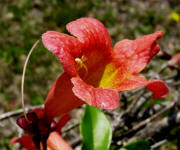
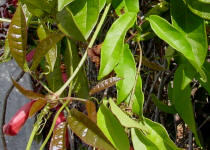
Family - Bignoniaceae
Grows on floodplains and moist woodland sites.
A fast growing, woody stemmed semi-evergreen Florida native vine to 40-50 feet long, climbing by tendrils which arise between the two leaflets of the pinnately compound leaves.
Colorful 2 - 3 inch trumpet shaped flowers appear in spring in various combinations of red, yellow and orange. Attracts Hummingbirds, fruit is a flattened bean-like capsule, 5-9 inches long containing winged seeds. Flowers are similar in appearance to those of the Trumpet creeper vine which has compound leaves with 7 - 15 leaflets.
Flame Vine - Pyrostegia venusta
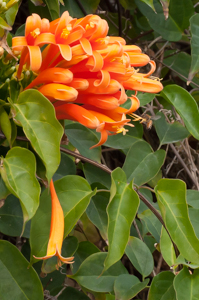
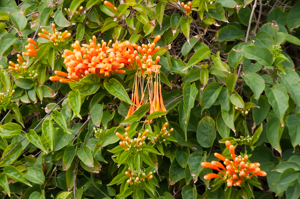
Invasive / Exotic
Family - Bignoniaceae
A fast growing evergreen climbing vine with woody stems. Vivid orange tubular flowers up 8 cm long with five reflexed petals are produced in terminal panicles. Leaves are opposite, compound with 2 or 3 leaflets and a 3 way forked tendril. Climbing to a trees canopy this vine then spreads horizontally and can completely engulf and smother trees, shrubs and structures. Vines over 15 meters in length are common. Flame vine does not set seed in Florida.
Trumpet Honeysuckle - Lonicera sempervirens
%20leaf_small.jpg)

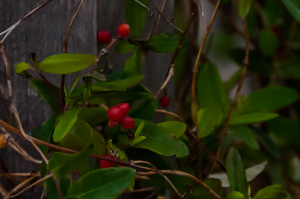
Family - Caprifoliaceae
Habitat - Open sunny areas of upland forests on well drained soils throughout Florida
Description - Native, woody, perennial twining or trailing vine, deciduous where freezes occur, otherwise evergreen. Leaves are elliptic, opposite, simple, with entire margins. Upper leaf surface is green and smooth, undersides appear whitish. Trumpet Honeysuckle has bright red, 2 inch tubular flowers are borne in terminal clusters and are very attractive to Butterflies & Hummingbirds. The fruit is a small (1/4 inch) red to orange berry, a favorite food of songbirds.
Poison Ivy - Toxicodendron radicans
_small.jpg)
%20Detail_small.jpg)

Family - Anacardiaceae
Habitat - Pine Flatwoods, Hammocks, Hardwood Swamps and forests statewide.
Description - Native perennial vine. Contact with any part of plant can cause rashes and blisters that may require medical treatment.
Leaf appearance is somewhat varied, generally palmately compound with three ovate leaflets that are shiny green when young, becoming dull green as they mature and may have a reddish tinge and black specks, turning red in the fall.
Flower - Clusters of tiny white flowers at leaf axils, fruit is a small white berry-like waxy drupe.
Climbing Aster - Ampelaster carolinianus

Family - Asteraceae
Habitat - Margins of swamps, marshes, freshwater creek and stream banks, open flatwoods.
Description - Native, Perennial shrub/vine.
Height - Variable, generally 6-12 feet.
Flower - 1 1/2 inch diameter, pink to lavender, with a yellow or reddish-yellow center.
Virginia Creeper - Parthenocissus quinquefolia

Family - Vitaceae
Habitat - Hammocks, Floodplain forests, Coastal areas, Flatwoods.
Description - Native, deciduous perennial vine. Leaves are palmately compound with five toothed leaflets. Foliage turns red in fall before dropping. Often confused with Poison Ivy which has 3 palmately arranged leaflets.
Flower - Inconspicuous, fruit is a black or bluish-black berry.
Mangrove rubber vine - Rhabdadenia biflora


Family - Apocynaceae
Habitat - Coastal Hammocks, Coastal Swamps and Salt Marshes.
Description - Native perennial climbing vine, stems may be 10 feet or more in length. Leaves are elliptic to slightly obovate with prominent veins and mid-rib.
Flower - White tubular flower with a yellow throat.
Devil's Potato, Rubber vine - Echites umbellata Jacquin
_small.jpg)
%202_small.jpg)
Family - Apocynaceae
Habitat - Coastal strand, hammocks, the margins of Mangrove swamps on the Atlantic coast.
Description - Native perennial climbing or clambering vine with milky white sap, 5 feet or more in length. Leaves are thick ovate, oppositely arranged with pointed tips and are V- shaped, related to the Alamanda and Frangipani.
Flower - Hanging 5-6 inch long funnel shaped flower with spiraled, ruffled white petals, blooming year-round in South Florida.
Hairy Clustervine - Jacquemontia tamnifolia

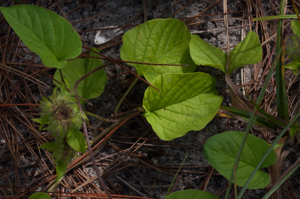
Family - Convolvulaceae
Florida native, found throughout the state. Annual, climbing, twining vine with stems up to 85 cm long, covered in long appressed hairs, leaves are ovate/ oblong with a cordate base, somewhat pilose with brown or whitish hairs. Flowers are small (1 cm), blue, produced in terminal or auxillary clusters with five petals fused into a tube or funnel form, fruit is a small brown capsule containing seeds.
Littlebell - Ipomoea triloba

Family - Convolvulaceae (Morning Glory family)
Common names include - Threelobe Morning-glory, Aiea Morning-glory
Native to the West Indies, Mexico, Belize and Trinidad. An annual twining or creeping vine. First recorded in a Montoe county orange grove in 1891, it quickly became a noxious weed/pest in many of Florida's orange groves.
Leaves are highly variable in size and shape and are 3/4 to 3 1/4 inches long, they may be heart shaped, or have 3 or 5 lobes. Small pink/pale purple flowers from leaf axils, singularly or in small clusters. Funnel-form flowers are 1/2/to 1 inch long with 5 lobes ending in an abrupt sharp point.
Common to disturbed areas such as groves, fence lines, agricultural fields and pastures.
Beach Morning-glory - Ipomoea imperati
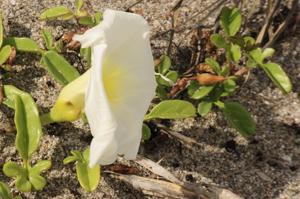
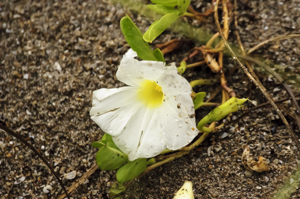
Family - Convolvulaceae
Native long lived perennial vine with a trailing habit of growth. The delicate, 2 inch (+/-) white funnel shaped flowers have a yellow center and open in the morning, wilting by the same afternoon. Flowers are produced year-round. Beach morning-glory can be found on coastal dunes throughout Florida.
Leaves are alternately arranged on a smooth stem, elliptic to ovate, lobed, leathery and succulent with a notched apex. Flowers attract humming birds and insects, various wildlife feed on this vines seeds.
